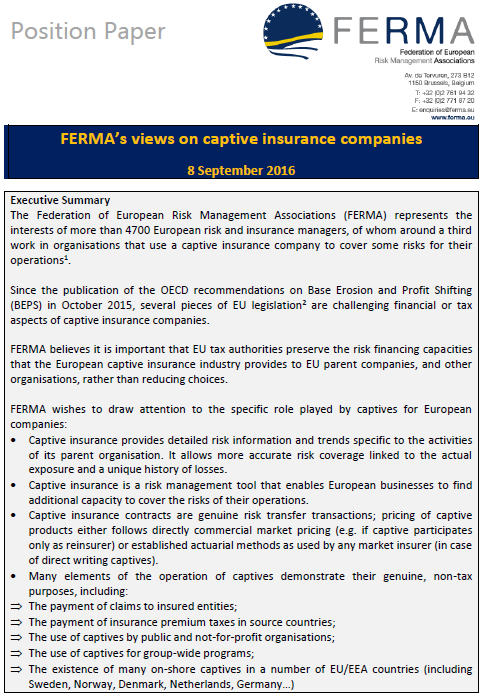FERMA has launched a campaign to change misperceptions of captive insurance by tax authorities and other public bodies.
As a starting point, FERMA has today published a position paper on captive insurance companies, which it will submit to the OECD so that the views of European risk managers are considered when the OECD discusses the implementation of its Base Erosion and Profit Shifting (BEPS) measures with member governments.
 FERMA will urge its 22 member associations across Europe to use the position paper to approach their national tax authorities, who will be responsible for deciding how to implement the BEPS measures, to explain the real risk management value of captives.
FERMA will urge its 22 member associations across Europe to use the position paper to approach their national tax authorities, who will be responsible for deciding how to implement the BEPS measures, to explain the real risk management value of captives.
In light of the latest corporate transparency and anti-tax avoidance measure at European Union level, FERMA will also reach out to the Commission and Parliament to increase their understanding of the role of captives in the European economy. This follows the adoption in July of the Anti-Tax-Avoidance (ATA) Directive by the Council of the EU
risk management role for European business and other organisations. We believe it is important that EU tax authorities understand better how European captives operate to preserve these risk financing capacities. This is not about tax, but a fear that the administrative costs of owning a captive will become uneconomic.”
FERMA will also raise the issues at the European Insurance and Occupational Pensions Authority (EIOPA) stakeholder group through its representative Marie-Gemma Dequae.
Key points in the paper include:
• Captive insurance enables European businesses to increase their capacity to take risk;
• The parent company gets a tailor-made risk coverage and pricing, and it can target risk reduction more effectively thanks to better loss information;
• Captive insurance contracts are genuine risk transfer transactions with pricing based on the same approaches as commercial insurers;
• European captives are regulated as other insurance entities under Solvency II;
• Many aspects of captive operations, such as the payment of insurance premium tax in source countries, demonstrate their genuine, non-tax functions.
Said Jo Willaert: “We find it ironic that Solvency II was designed to include as much as possible captives as normal regulated insurance companies, despite requests from the risk management community for more proportional regulation, and now BEPS and Commission initiatives are differentiating captives from the rest of insurance companies.”
BEPS and EU anti-tax avoidance and financial transparency initiatives will be the subject of a risk managers only discussion at the FERMA Seminar in Malta on 3 and 4 October. There will also be a presentation on captive insurance and cells in Malta. For more information, see https://www.ferma.eu/event/ferma-seminar-2018/